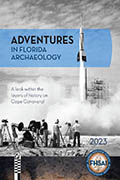
Artist, sculptor, illustrator and writer Frederic Remington, or to be formal, Frederic Sackrider Remington ( October 4, 1868 – December 26, 1909,) is world famous for his works depicting America’s ‘Old West’ in the decades after the Civil War. His images of intrepid soldiers, noble Indians and hardscrabble cowboys define the American memory of the era.

So why is there an important article on him in the Library of Florida History’s collection of the Florida Historical Quarterly, Vol. 56, 1977-78, all the way to the left on the bottom shelf?
Well, by the 1890’s America’s Old West was gone, tamed by the suppression of the Native Americans, the industrialization of the cattle business and the importation of all that east coast civilization. What was a young artist, famed for his depictions of an extinct lifestyle, to do?
Go South, young man, go South.

Florida in the 1890s was the frontier. South of Orlando the population averaged two people per square mile. There were cattle herds and cattle rustlers and the Florida Cracker Cowboys, who often were one and the same. There was not much law, and local issues were often dealt with by what we now genteelly call “extra legal means”.

That is not in the sense of additional lawyers filing motions.

It would do for a frontier artist, and in 1895 Remington got a commission to travel to Florida and document it. It turns out Remington’s drawings are in the hands of a private collector, but they are duplicated in an article in the Quarterly.

Knowing even this final frontier was going to be a thing of the past, Remington adapted, and in May, 1895, produced this single page spread for Harper’s Weekly (which is in the collection), extolling the joys of fishing and, especially, hunting... as in shooting sitting ducks... on Florida’s southwest coast.

Why fish, he wondered, when you could grab a gun and sail right up to ducks who didn’t know to fly away and quickly fill your game pouch to overflowing.

In 1898 Remington made one more trip to Florida, and documented the daily life of soldiers preparing to go to Cuba and follow Teddy up San Juan Hill and into the history books. That, of course, is another story.







